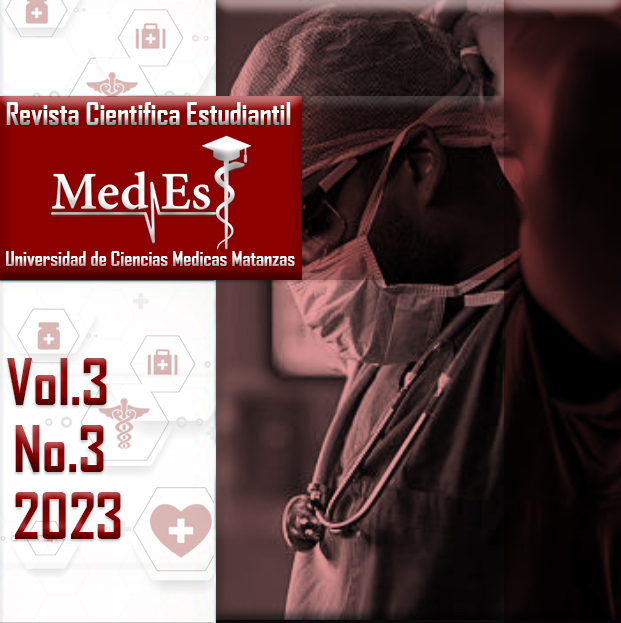Neuroimaging techniques in pediatric patients
Keywords:
Diseases, Diagnosis, Neuroimaging, Pediatrics, Techniques, TreatmentAbstract
Introduction: before the advent of neuroimaging techniques, scientists had to rely on much more precarious means to get closer to understanding the nervous system. Imaging diagnostic techniques have revolutionized the methods of detecting diseases in individuals, both adults and pediatric ages.
Objective: to describe the application of neuroimaging techniques in the diagnosis and treatment of pediatric conditions of the central nervous system.
Methodological Design: a bibliographic review was carried out from July to August 2023, where original articles, case reports and open access systematic reviews in peer-reviewed academic publications from the last 5 years were consulted. The databases of SciELO, Regmed, Dialnet, Mayoclinic, among others, were reviewed.
Results: some of the neuroimaging techniques currently used are: Magnetic Resonance, Positron Emission Tomography, Electroencephalography and Magnetoencephalography (MEG), which are applied in both fetal, neonatal and pediatric medicine.
Conclusions: the use of magnetic resonance imaging is highlighted as a gold standard for the imaging study of the brain, in the first years of life, without forgetting the multiple applications and advantages of CT and other more recent ones such as MEG.
Downloads
References
1. Colectivo de autores. Las técnicas de neuroimagen. [Internet] 2016. [citado 02/09/2023]; 3(2): [aprox. 5 p.]. Disponible en: https://dialnet.unirioja.es/servlet/libro?codigo=422653
2. Bareither I. Historia de las imágenes cerebrales. [Internet]. 2018. [citado 02/09/2023]; 1(2): [aprox. 1 p.]. Disponible en: https://dialnet.unirioja.es/servlet/articulo?codigo=7456458
3. Blanco K, Salcidua S, Orellana P, Sauma-Pérez T, León T, Steinmetz LCL, et al. Systematic review: fluid biomarkers and machine learning methods to improve the diagnosis from mild cognitive impairment to Alzheimer's disease. Alzheimers Res Ther. [Internet] 2023; [citado 20/10/2023]; 15(1):176. Disponible en: https://pubmed.ncbi.nlm.nih.gov/37838690/
4. Carvalho Gómez CA. El origen de las técnicas de Neuroimagen. [Internet]. 2016. [citado 02/09/2023]; 10 (2): [aprox. 3 p.]. Disponible en: https://hablemosdeneurociencia.com/el-origen-de-las-tecnicas-de-neuroimagen/
5. Martín Martínez C, Escofet Soteras C. Diagnóstico mediante resonancia magnética fetal de las malformaciones del sistema nervioso central. Rev Neurol [Internet] 2006 [citado 02/09/2023]; 43 (Supl. 1):S115-S120. Disponible en: https://neurologia.com/articulo/2006448/esp
6. Ashton NJ, Hye A, Rajkumar AP, Leuzy A, Snowden S, Suárez-Calvet M, et al. Una actualización sobre biomarcadores sanguíneos para trastornos neurodegenerativos no relacionados con el Alzheimer. Nat Rev Neurol. [Internet] 2020 [citado 02/09/2023]; 16(5):265–284.Disponible en: https://pubmed.ncbi.nlm.nih.gov/32322100/
7. Gardea Loera G, Velazco Campos M. Aspectos clínicos de neuroimagen y comportamiento electrofisiológico de la hidranencefalia. Arch Neurocien [Internet]. 2014. [citado 02/09/2023]; 19(1):48-52. Disponible en: https://www.medigraphic.com/cgi-bin/new/resumen.cgi%3FIDARTICULO%3D50323&ved=2ahUKEwjSoqL0w8DxAhUXmmoFHYtmCNgQFjAAegQIBBAC&usg=AOvVaw3NPrmKhMUpdCgYkyRObrOe
8. Castillo AM, Mena Olmedo G, Hernández D, Carrillo E, Aguirre J. Diagnóstico intraútero de hidranencefalia en relación a un caso clínico. [Internet]. 2018 [citado 03/09/2023]; 3 (2): [aprox. 5 p.]. Disponible en: https://www.webcir.org/revistavirtual/articulos/junio14/ecuador/ecu_esp.pdf&ved=2ahUKEwj2lLKnxMDxAhXkk2oFHfx5BdUQFjAAegQIAxAC&usg=AOvVaw1gNY9IX77zmxUhmGspRmkh
9. Fernández Mayoralas D, Recio Rodríguez M, Fernández Jaén A, Jiménez de la Peña M, Marrero Brito J, Muñoz Jareño N. Resonancia magnética fetal en la esclerosis tuberosa. Acta Pediatr Esp. [Internet]. 2018. [citado 03/09/2023]; 13(1): [aprox. 27 p.]. Disponible en: https://dialnet.unirioja.es/servlet/articulo%3Fcodigo%3D6042649&ved=2ahUKEwijjpvWxMDxAhVklGoFHXxoD7UQFjAAegQIAxAC&usg=AOvVaw2YL5YfbPtXcBAvbB5uvnHE
10. Bendersky M. Imágenes por Resonancia Magnética del cerebro prenatal. [Internet]. 2019. [citado 03/09/2023]; 1(7): [aprox. 21 p.]. Disponible en: www.sciens.com.ar
11. Colectivo de autores. Neuroimagen neonatal y pediátrica. [Internet]. 2019. [citado 04/09/2023]; 5(2): [aprox. 12 p.]. Disponible en: http://neurocienciasmexico.com/index.php
12. Ferreira Moreno V, González Hernández G, Martí Coruña M. Rufín Arregoitia A. Infecciones congénitas del Sistema Nervioso Central. [Internet]. 2020. [citado 04/09/2023]; 1(8): [aprox. 8 p.]. Disponible en: http://www.revmedicaelectronica.sld.cu/
13. Colectivo de autores. Técnica de neuroimagen podría ayudar a predecir el autismo en bebés de alto riesgo. Science Translational Medicine. [Internet]. 2019. [citado 04/09/2023]; 1(1): [aprox. 2 p.]. Disponible en: https://espanol.nichd.nih.gov/
14. Baptista T, Quaghebeur G, Alarcon A. Hallazgos de neuroimagen en niños con microcefalia y posible infección congénita por el virus zika. [Internet]. 2018. [citado 06/09/2023]; 5(5): [aprox.14 p.]. Disponible en: https://www.neurologianeonatal.org/portfolio_category/articulos/
15. Colectivo de autores. Efectividad de los estudios de neuroimagen en niños con cefalea. Anales Españoles de Pediatría. [Internet]. 2021. [citado 06/09/2023]; 3(2): [aprox. 17 p.]. Disponible en: https://www.aeped.es/sites/default/files/anales/49-5-10.pdf&ved=2ahUKEwj6rdGKxcDxAhWyk2oFHSfdCtkQFjAAegQIAxAC&usg=AOvVaw3gXOI0aA7Ww-l9sRAcdMjY
16. Valdivia Álvarez I, Odales Ibarra R. Neuroimagen en niños con epilepsia de difícil control. [Internet]. 2022. [citado 06/09/2023]; 8(8): [aprox. 8 p.]. Disponible en: http://scielo.sld.cu/scielo.php?script=sci_serial&pid=0034-7531&lng=es&nrm=iso
17. Colectivo de autores. Tumores de Sistema Nervioso Central en Pediatría: Presente y Futuro del Abordaje Diagnóstico. [Internet]. 2021. [citado 10/09/2023]; 2(12): [aprox. 2 p.]. Disponible en: http://scielo.senescyt.gob.ec/scielo.php%3Fscript%3Dsci_arttext%26pid%3DS2631-25812017000200283&ved=2ahUKEwi80ZLyxcDxAhW8lWoFHQJyBdkQFjANegQIHhAC&usg=AOvVaw3BNq5oO0h-W9LiW4irx__W
18. Fernández Jaén A, Calleja Pérez B, García Asensio JA. Traumatismo craneoencefálico en la infancia. [Internet].2020 [citado 10/09/2023]; 2(2): [aprox. 22 p.]. Disponible en: https://www.elsevier.es/es-revista-medicina-integral-63-articulo-traumatismo-craneoencefalico-infancia-12003811
19. Santiuste M, Nowak R. Nuevas aportaciones de la neuroimagen funcional: la magnetoencefalografía en el estudio de la dislexia. [Internet]. 2019. [citado 10/09/2023]; 4(1): [aprox. 34 p.]. Disponible en: https://www.redalyc.org/pdf/3498/349832314025.pdf
Downloads
Published
How to Cite
Issue
Section
License
Copyright (c) 2024 Dionis Ruiz-Reyes, Néstor Miguel Carvajal-Otaño, Roxana García-Arencibia

This work is licensed under a Creative Commons Attribution-NonCommercial 4.0 International License.
Those authors who have publications with this journal accept the following terms: The authors will retain their copyright and guarantee the journal the right of first publication of their work, which will be simultaneously subject to the Recognition License. Creative Commons that allows third parties to share the work as long as its author and its first publication in this magazine are indicated. Authors may adopt other non-exclusive license agreements for the distribution of the published version of the work (e.g.: deposit it in an institutional telematic archive or publish it in a monographic volume) as long as the initial publication in this journal is indicated. Authors are allowed and recommended to disseminate their work through the Internet (e.g.: in institutional telematic archives or on your website) before and during the submission process, which can produce interesting exchanges and increase citations of the published work.





